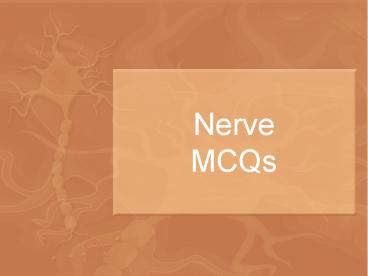Nerve MCQs - PowerPoint PPT Presentation
Title:
Nerve MCQs
Description:
Nerve MCQs A grouping of cell bodies located within the central nervous system is known as a tract. nerve. nucleus. ganglion. Involuntary effectors (glands, smooth or ... – PowerPoint PPT presentation
Number of Views:185
Avg rating:3.0/5.0
Title: Nerve MCQs
1
NerveMCQs
2
A neuron generally has all of the following
principle areas except
- microvilli.
- a cell body.
- dendrites.
- an axon.
3
Which of the following is not a function of
neurons?
- Respond to physical and chemical stimuli.
- Conduct electrical impulses.
- Release specific chemical regulators.
- All of these are neuron functions.
4
A grouping of cell bodies located within the
central nervous system is known as a
- tract.
- nerve.
- nucleus.
- ganglion.
5
Involuntary effectors (glands, smooth or cardiac
muscle) are innervated (stimulated by)
- autonomic neurons.
- efferent neurons.
- motor neurons.
- association neurons.
6
A grouping of cell bodies located within the
central nervous system is known as a
- bipolar
- multipolar
- pseudounipolar
7
Myelin sheaths around axons located within the
CNS are formed by
- Schwann cells.
- microglia.
- astrocytes.
- oligodendrocytes.
8
Which of the following cell types is not a
supporting cell or glial cell of the nervous
system?
- Schwann cell
- oligodendrocyte
- astrocyte.
- association neuron
9
The glial cells in the CNS which are capable of
phagocytosis are
- astrocytes.
- oligodendrocytes.
- satellite cells.
- microglia.
10
Within the central nervous system astrocytes are
responsible for
- myelinateing axons.
- producing cerebrospinal fluid.
- phagocytizing particulate matter.
- aid in synapse formation.
11
In the absence of stimuli, all cells in the body
maintain a potential difference across the
membrane called the _____, in which the inside of
the cell is negatively charged in comparison to
the outside of the cell.
- action potential
- threshold potential
- resting membrane potential
- graded potential
12
The term "voltage regulated" means that the
membrane
- voltage gated ion channels open and close with
changes in the membrane potential. - potential is controlled by the Na/K pumps.
- gates will not respond unless the voltage is
"regular." - potential can only be controlled by an
oscilloscope.
13
The diffusion of K out of the cell makes the
inside of the cell less positive, or more
negative, and acts to restore the original
resting membrane potential -a process called
- depolarization.
- hyperpolarization.
- repolarization.
- overshoot.
14
Both the depolarization and repolarization
changes that occur during the action potential
are produced by
- simple diffusion of ions down their concentration
gradients. - active transport pumps along the neuron membrane.
- negative feedback loops.
- carrier mediated transport.
15
Nerve impulses (action potentials) are conducted
along an axon without decrement. This means the
action potentials are conducted without
- decreasing velocity.
- altering the threshold potential.
- decreasing amplitude.
- altering the Na or K concentrations in the
neuron.
16
Which of the following is not a neuron-neuron
synapse?
- neuromuscular junction
- axosomatic synapse
- axoaxonic synapse
- dendrodentritic synapse
17
Electrical synapses
- occur when two cells are joined by integrin
proteins. - are characterized by a synaptic cleft.
- occur between two cells of unequal size.
- require the presence of gap junctions.
18
The small membrane-enclosed compartments that
hold and release the neurotransmitter molecules
from within the presynaptic neuron, are called
- synaptic vesicles.
- synaptic clefts.
- terminal boutons.
- gap junctions.
19
As the intensity of the stimulus in a
presynaptic neuron increases, the number of
vesicles undergoing exocytosis ___, and the
number of released neurotransmitter molecules
____.
- increases increases
- increases decreases
- decreases increases
- decreases decreases
20
The blood-brain barrier is composed of two cells
types, endothelial cells and
- oligodendrites
- microglia
- Schwann cells
- astrocytes































